Korean Beef Bulgogi – Quick + Easy! (VIDEO)
This post may contain affiliate links. Please read our disclosure policy.
Korean Beef Bulgogi is one of the most popular Korean BBQ dishes – the thinly sliced beef is marinated in a delicious, flavorful marinade (read below for my secret ingredient) and cooked quickly over high heat. My quick and easy recipe is perfect for any occasion – and best of all, it’s my Korean wife approved!

Watch the Beef Bulgogi Recipe Video Below!
Table of Contents
- Watch the Beef Bulgogi Recipe Video Below!
- Korean Pear = Secret Ingredient for the Best Beef Bulgogi!
- Ingredient Tips
- What Kind of Beef?
- Korean Beef Bulgogi: Recipe Instructions
- Don’t Overcrowd the Pan!
- Expert Tips for Korean Beef Bulgogi
- How to Store Korean Beef Bulgogi
- What to Eat/Serve with Korean Beef Bulgogi?
- Korean Beef Bulgogi (Video) Recipe
Beef Bulgogi is an extremely popular type of grilled meat dish that you can find at every Korean BBQ restaurant. Bulgogi translates to “fire meat” in Korean, and can be made with beef, chicken or pork. (Check out my Spicy Pork Bulgogi if you are looking for spicer pork version!) My other favorite Korean BBQ dish is Korean Marinated Short Ribs (LA Galbi), which is a crowd pleaser!
The best part about this recipe (other than how delicious it is!) is how EASY it is – the marinade comes together super quickly and once mixed with the beef, all you have to do is wait! I love making this for the week because it cooks super quickly in a cast iron or pan. (But if you have access to a charcoal grill, that’s even better!)
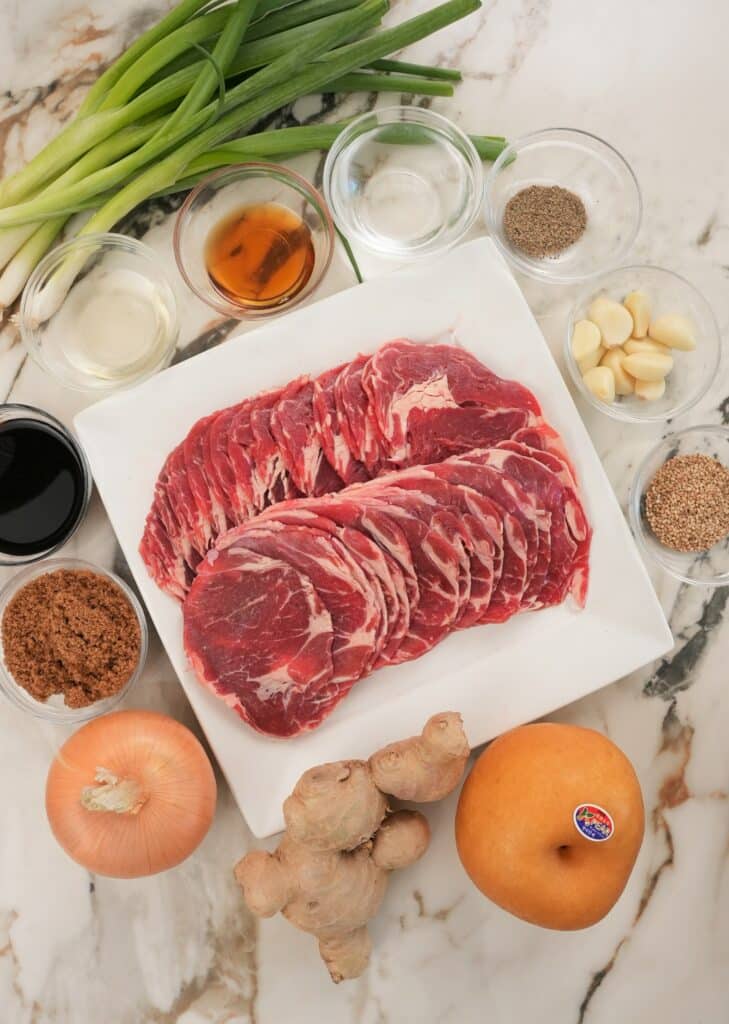
Key Tip
Korean Pear = Secret Ingredient for the Best Beef Bulgogi!
This is my SECRET ingredient for the best Korean Beef Bulgogi! Korean Pears (sometimes labeled as Asian Pears or Apple Pear) contain an enzyme called Calpain that helps tenderize the meat. The natural sweetness of the pear also adds to the layers of flavor in the beef.
Some recipes call for grating your Korean Pear – I think it’s just as effective and much easier to blend the Korean Pear into your marinade!
If you cannot find Korean Pears, you can substitute with an apple, kiwi, or even a pineapple.
Whichever fruit you use, make sure to use a cheese cloth bag or a fine mesh strainer to strain the pulp into a large mixing bowl – you should only use the juice and not the pulp in the marinade!
Ingredient Tips
This is the best kind of marinade recipe because all you have to do is blend the ingredients together – read below for my notes –
- thinly sliced beef – see note below
- You can also use this marinade with chicken – I like to use chicken thighs.
- soy sauce – Use light soy sauce (not low sodium) or all-purpose soy sauce. Do NOT use dark soy sauce!
- mirin – this is a sweet cooking wine that is used frequently in Korean and Japanese cooking. It provides a great balance to the soy sauce in this recipe.
- If you don’t have mirin, you can substitute with rice vinegar but add 1 tsp of sugar, as rice vinegar does not have the sweetness of mirin.
- Korean pear – see note above
- brown sugar – this will add a bit of sweetness to the marinade to balance out the savory flavors
- sesame oil – this adds a nutty element to the marinade
See the recipe card for full information on ingredients and quantities.
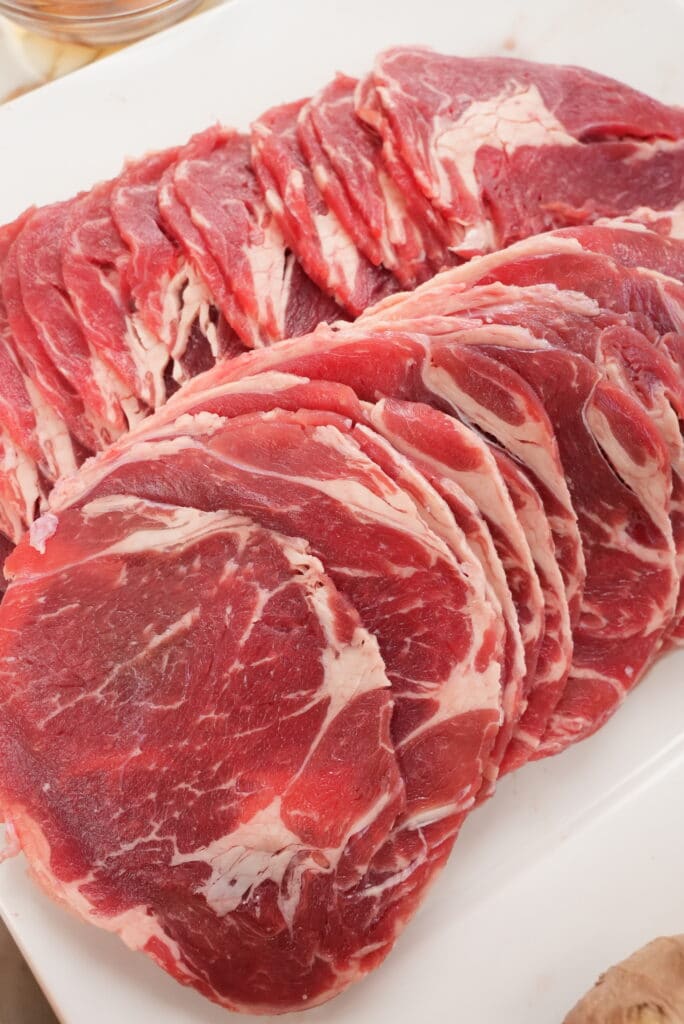
Key Tip
What Kind of Beef?
The key is to use thinly sliced beef (the thinner, the better) – I purchase mine from my local Asian grocery (H Mart), where it’s already pre-sliced into 1/8″ thin (2-3mm) pieces. They’re usually in the frozen or refrigerated butcher section, labeled to be used for Korean BBQ or hot pot (sometimes labeled as “spencer cut”).
If you can’t find pre-sliced meat, you can slice it yourself!
Look for beef that has streaks of white throughout the meat. This is fat (or “marbling”) that will ultimately render out and create a juicy, flavorful end result.
Wrap your beef (I would use rib eye) in plastic wrap or place in a freezer safe bag; place in the freezer for 30 minutes. Frozen beef will be much easier to slice yourself.
Once frozen for 30 minutes, remove from the freezer. Remove the plastic wrap or from the freezer safe bag and place on your cutting board.
Use a sharp knife and slice AGAINST the grain into 1/4 – 1/8″ thin slices (as thin as you can). It doesn’t have to be perfect!
Korean Beef Bulgogi: Recipe Instructions
1. Mix Together the Marinade
The first step in making this recipe is mixing together the marinade. In a blender or food processor, add the Korean pear, onion, garlic, ginger, and water and blend until smooth.
Some recipes will call for grating – I like to use a blender for ease and convenience. I have tried the grating method and I noticed ZERO difference in the end result.
Korean pear has a tenderizing enzyme called Calpain. This is what is going to tenderize our beef and one of the secrets to great Korean BBQ!

2. Strain the Pulp
This is a KEY step in making your marinade – so do not skip it! The blended marinade will have the pulp of all of your ingredients, which you do not want to use. (Otherwise, when you are cooking your Korean Beef Bulgogi, you’ll also be cooking the pulp of onions, ginger, pear, etc.)
Use a cheese cloth bag or a fine mesh strainer to strain the pulp into a large mixing bowl – you should be left with only the juices.
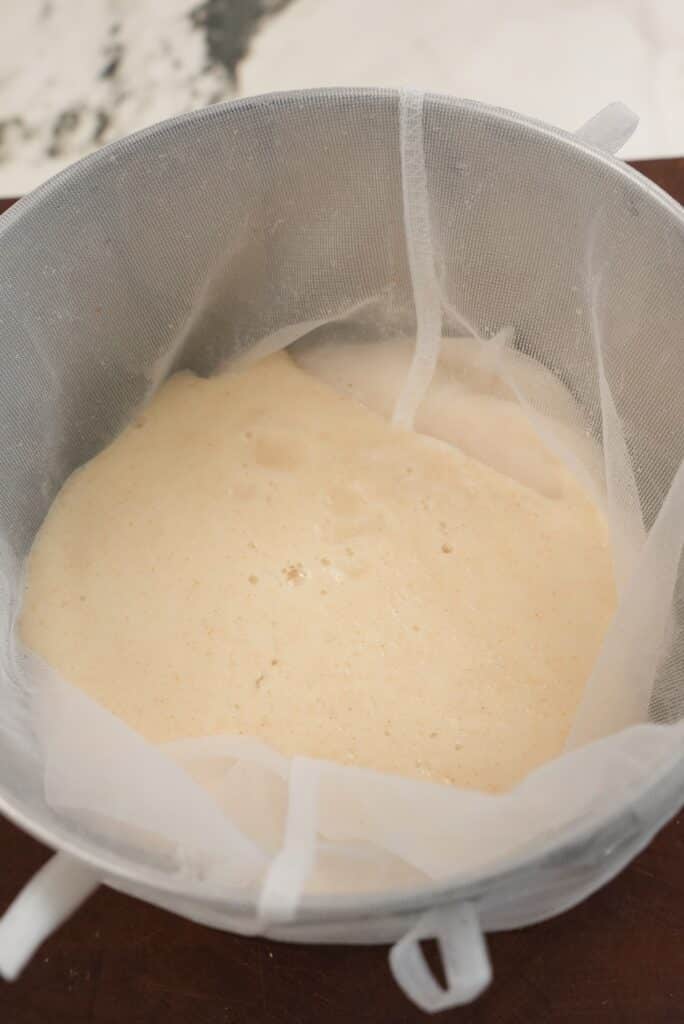
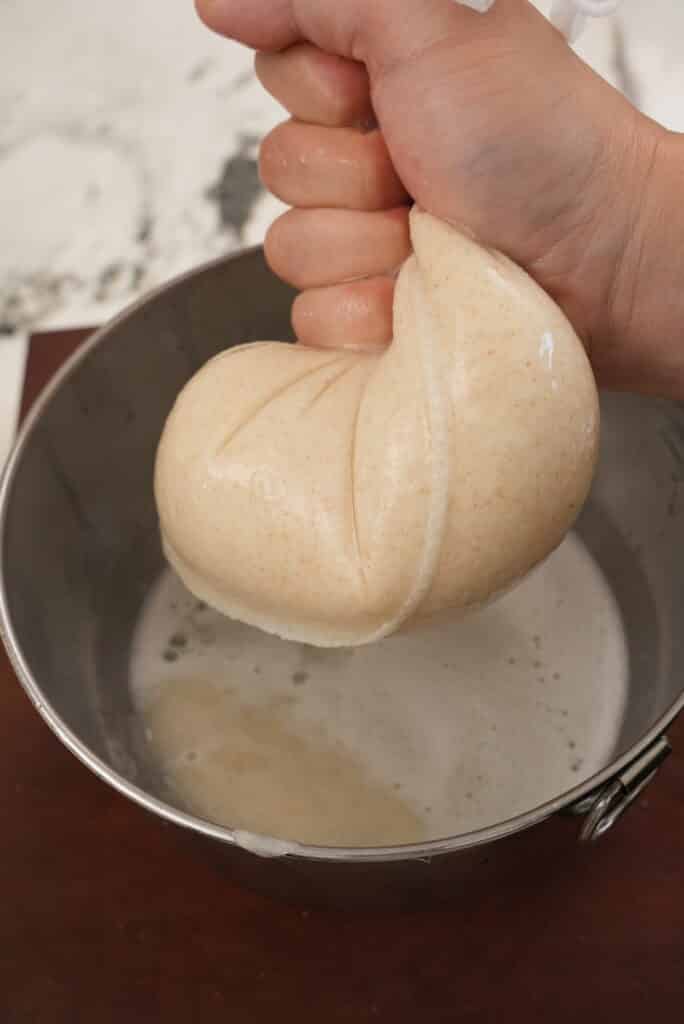
3. Add In The Seasonings and Beef
Next, add light soy sauce, brown sugar, mirin, sesame oil, and black pepper to the strained juice. Once the marinade is thoroughly mixed, add in the thinly sliced beef along with the thinly sliced onions and scallions. Using your hand, mix all the ingredients together until the beef is thoroughly coated in the marinade.
Let this marinate in the refrigerator for 4-8 hours or overnight for best flavor.
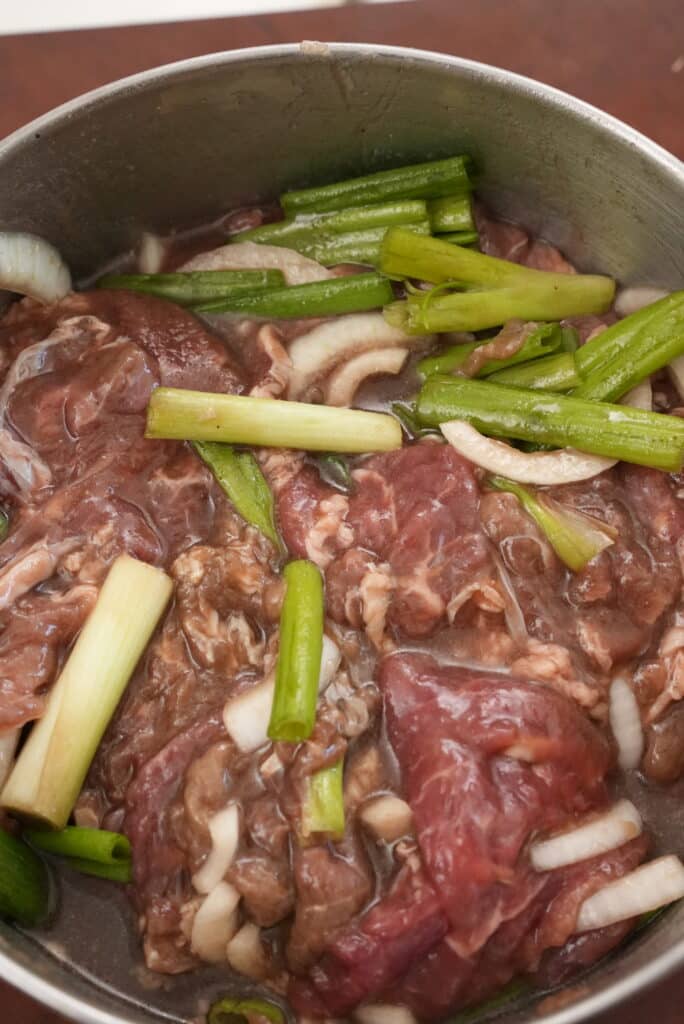
4. Cook The Beef
Cook the beef in a heavy bottomed carbon steel or cast iron pan (a charcoal grill works great too!) on high heat for about 4-5 minutes or until the beef is fully cooked through.
You may see lot of water get cooked out during the cooking process – this is completely normal!
PRO TIP
Don’t Overcrowd the Pan!
Make sure to not overcrowd the pan and cook the beef bulgogi in smaller batches to maintain the high heat in your pan. Because the marinade has sugar from multiple sources (Korean Pear, Mirin, Brown Sugar), you will be able to caramelize your Korean Beef Bulgogi and get delicious crispy edges. If you cook in batches that are too large, the pan will lose too much heat and the excess water will end up steaming/boiling your meat.
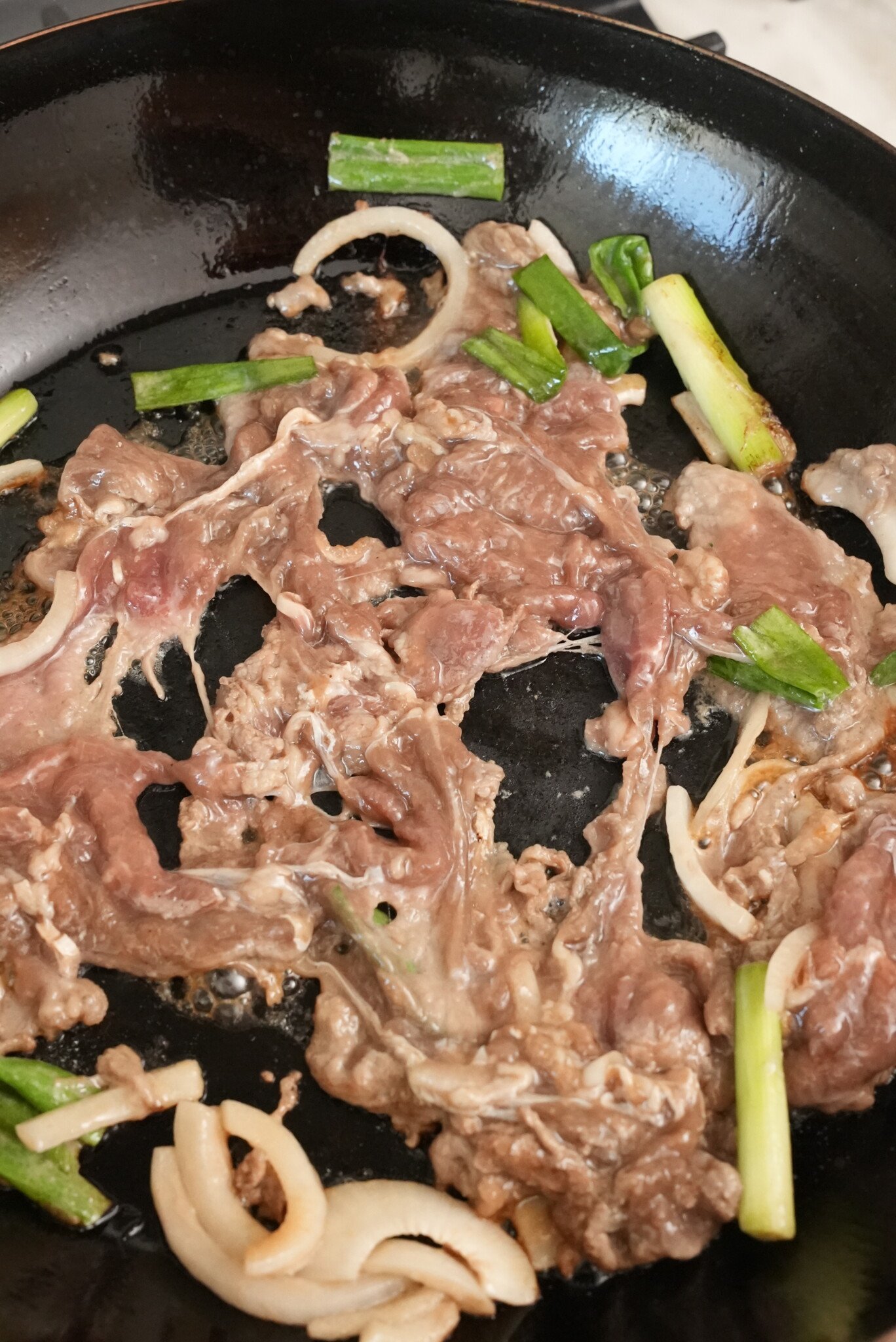
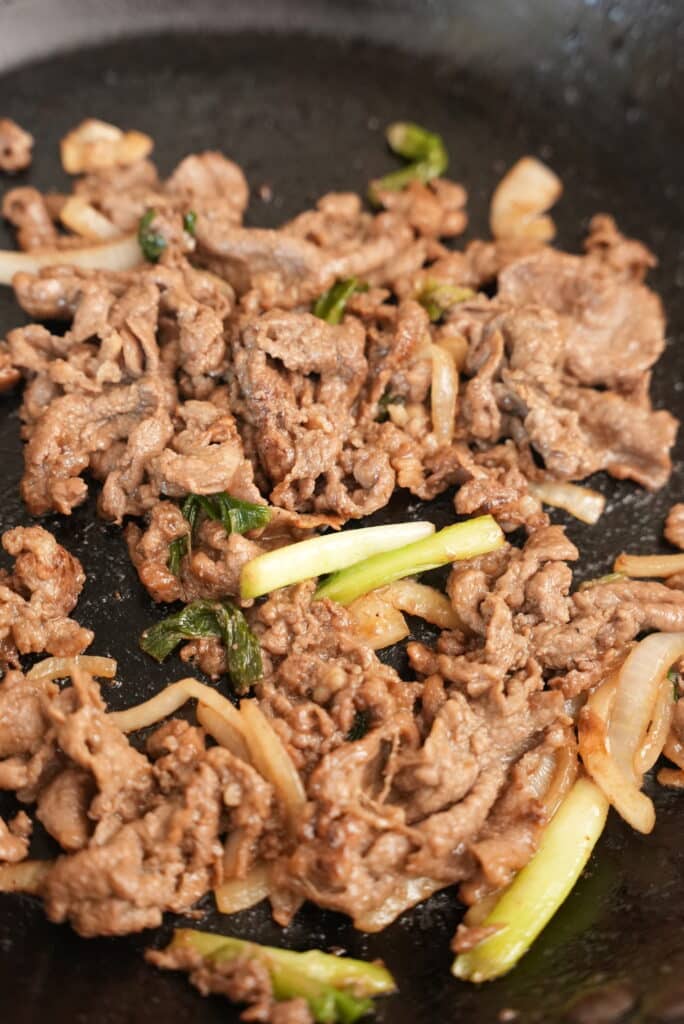
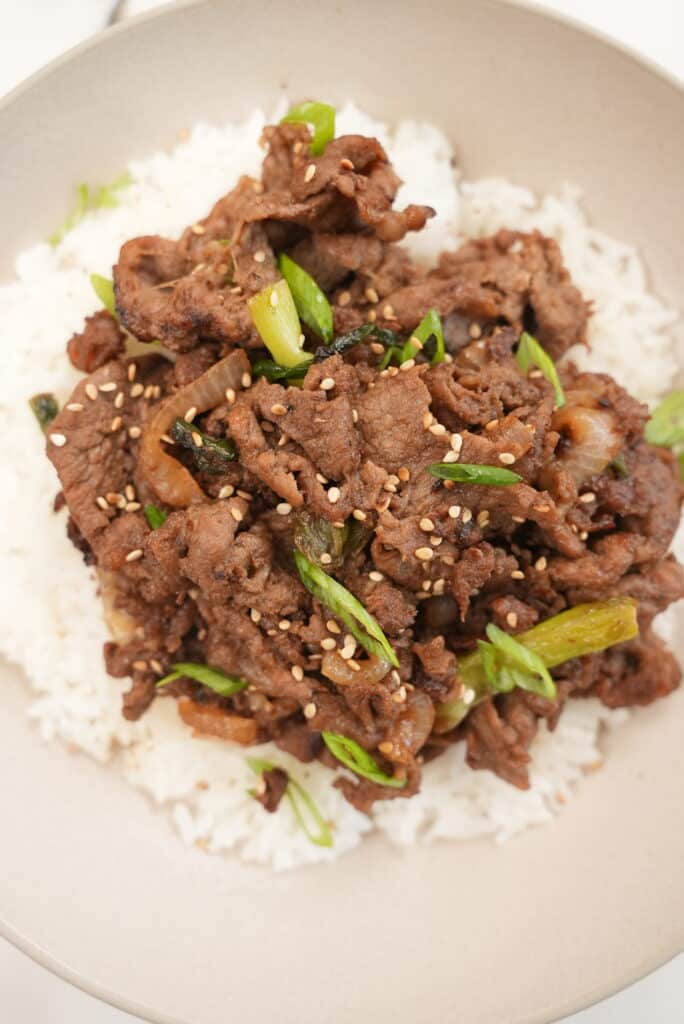
PRO TIPS
Expert Tips for Korean Beef Bulgogi
- Strain Your Marinade to Remove Pulp
- This is a KEY step in making your marinade – so do not skip it! The blended marinade will have the pulp of all of your ingredients, which you do not want to use. (Otherwise, when you are cooking your Korean Beef Bulgogi, you’ll also be cooking the pulp of onions, ginger, pear, etc.)
- Use a cheese cloth or a fine mesh strainer to strain the pulp into a large mixing bowl – you should be left with only the juices.
- Marinate for at least 4-8 hours (overnight is best)
- Avoid Over-Crowding When Cooking
- Make sure to cook them in smaller batches to maintain the heat in your pan. Because the marinade has sugar from multiple sources (Korean Pear, Mirin, Brown Sugar), you will be able to caramelize your Korean Beef Bulgogi and get delicious crispy edges. If you cook in too large batches, the excess water will end up steaming/boiling your meat.
How to Store Korean Beef Bulgogi
- Marinated beef (not cooked)
- Refrigerator: 4-5 days in an air tight container in the refrigerator
- Freezer: 2-3 weeks in an air tight container or freezer safe bag in the freezer
- I recommend portioning out your meat BEFORE freezing it; otherwise you will need to defrost all of it at once.
- Cooked beef
- Refrigerator: 2-3 days in an airtight container in the refrigerator
What to Eat/Serve with Korean Beef Bulgogi?
One of the best parts of Korean BBQ is the Korean side dishes (called “banchan”) – so when making Korean Beef Bulgogi at home, I would serve it with my favorite side dishes:
- If you need some extra vegetables, make my Korean Cucumber Salad – it’s light, refreshing, and has just a tiny bit of spice.
- For a simple vegetable dish with no spice, try my Korean Bean Sprout Salad.
- You can never eat too much broccoli, so make my Korean Broccoli Salad (which is my wife’s family’s recipe)
- When we go out to Korean BBQ, Korean Stir-Fried Fish Cakes are the first banchan that gets eaten up!
- It’s not Korean BBQ without some Korean Cheese Corn – this is a crowd pleaser!
- I love eating Korean Beef Bulgogi with Korean Spinach Side Dish (or when I want something spicy, Spicy Korean Spinach Side Dish!)
If you tried this Korean Beef Bulgogi or any other recipe on my website, please leave a 🌟 star rating and let me know how it went in the comments below!
Korean Beef Bulgogi (VIDEO)
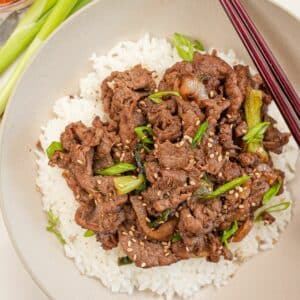
Equipment
Ingredients
Marinade
- 1 Korean pear, cut into large chunks
- 1 medium onion, cut into large chunks
- 8 cloves garlic
- 1 inch ginger
- 1/4 cup water
- 1/2 cup light soy sauce
- 2 tbsp mirin
- 1/4 cup brown sugar
- 1 tbsp sesame oil
- 1/2 tsp black pepper
- 2 lb thinly sliced steak, I used ribeye; you can also ask your butcher for steak sliced 3mm or 1/8" thick
Ingredients to marinate with beef
- 1 white onion, thinly sliced
- 3 green onions, cut into 2" pieces
- 2 tbsp neutral oil, divided
- sesame seeds, optional garnish
Instructions
- To a blender or food processor, add cubed Korean pear, onion, garlic, ginger, and water. Blend until smooth.
- Use a cheese cloth to strain out the pulp and leave the juice in a large mixing bowl. To the strained liquid, add light soy sauce, mirin, brown sugar, sesame oil, and black pepper. Mix until the sugar has dissolved, then add the thinly sliced beef, thinly sliced onions, and green onions. Mix and marinate for at least 8 hours or up to 24 hours.
- Over high heat, add a tbsp of oil to a large pan. Cook half of the beef bulgogi in batches until the liquid has evaporated and the beef and onions are nicely caramelized, about 4-5 minutes. Remove to a plate and repeat with the rest of the oil and bulgogi.
- Serve with freshly steamed rice and garnish with sesame seeds and chopped scallions.
Video
Notes
Nutrition
Nutrition information is automatically calculated, so should only be used as an approximation.


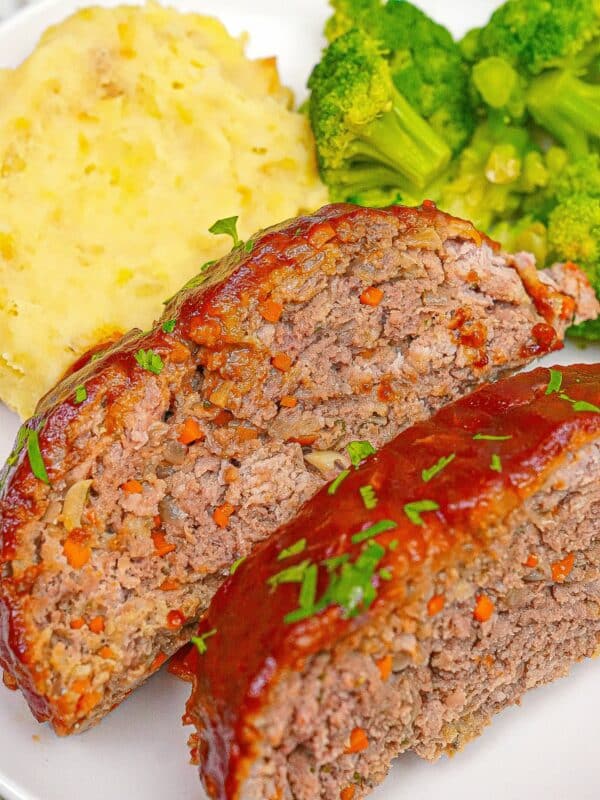

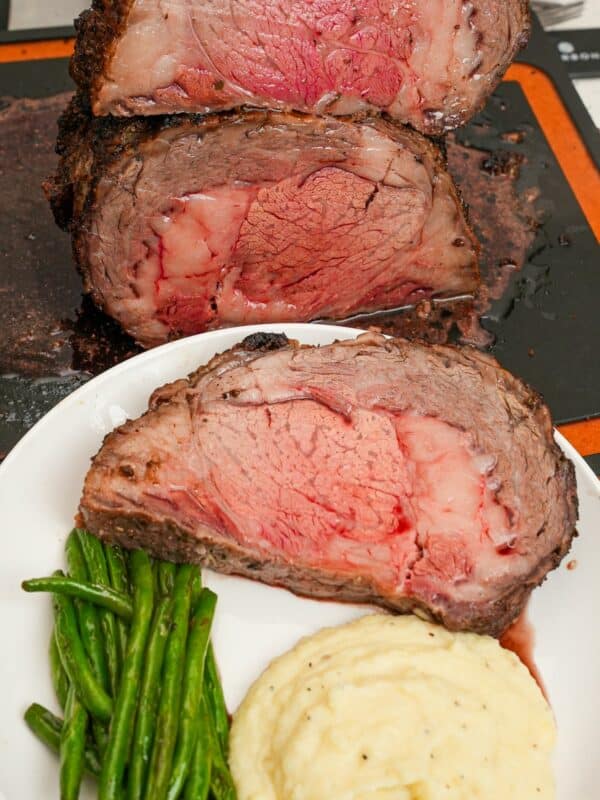







Hello. Can I use american pear?
I’d actually suggest using pineapple or kiwi instead if you can’t find asian or korean pear. The enzymes in those fruits will work similarly!
Thank you for posting this recipe! It was a hit tonight. I only marinated some of the meat for a couple of hours but it still had so much flavor and the rest if the meat will be marinated for the rwst of the night. This was way better then the bibigo bulgogi sauce. Thanks again!
I’m so glad you enjoyed it, Michele!
When does the 1/4 cup of water come in? I can’t seem to find it anywhere in the instructions? I’m assuming that you blend it in with step one? thank you.
When does the 1/4 cup of water come in? I can’t seem to find it anywhere in the instructions? I’m assuming that you blend it in with step one? thank you.
Hi Katelin – yes, it’s added to the blending step! I just updated the instructions to clarify – thanks so much for pointing that out and I hope you enjoy the recipe!
My kids and I always look foward to cooking one of your recipes. The videos and easy directions are perfect. This one has become my favorite next to the beef and broccoli. Must try if you haven’t already.
This is absolutely amazing. Followed it in detail and tastes just like a restaurant. Wish I could eat it weekly!
CJ’s recipes don’t fail. This one was a huge winner for my family. I wish I could afford to make it weekly. Perfect for a special occasion. Yum! Tastes just like a restaurant.
I just love Bulgogi!
Thank you for sharing!!
Added to my favorites!
The best bulgogi I ever had !!!!!!!! I used ribeye thinly sliced, prepped it before work, 10 hours later it was all I was looking forward to!! So good
Thank you Serena!